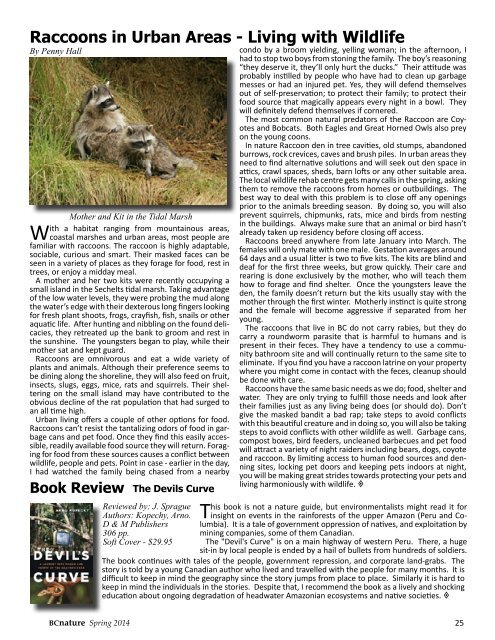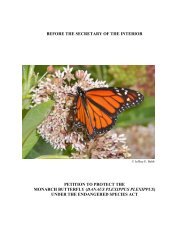BC-Nature-Spring-2014-web-final
BC-Nature-Spring-2014-web-final
BC-Nature-Spring-2014-web-final
You also want an ePaper? Increase the reach of your titles
YUMPU automatically turns print PDFs into web optimized ePapers that Google loves.
Raccoons in Urban Areas - Living with Wildlife<br />
By Penny Hall<br />
Mother and Kit in the Tidal Marsh<br />
With a habitat ranging from mountainous areas,<br />
coastal marshes and urban areas, most people are<br />
familiar with raccoons. The raccoon is highly adaptable,<br />
sociable, curious and smart. Their masked faces can be<br />
seen in a variety of places as they forage for food, rest in<br />
trees, or enjoy a midday meal.<br />
A mother and her two kits were recently occupying a<br />
small island in the Sechelts tidal marsh. Taking advantage<br />
of the low water levels, they were probing the mud along<br />
the water’s edge with their dexterous long fingers looking<br />
for fresh plant shoots, frogs, crayfish, fish, snails or other<br />
aquatic life. After hunting and nibbling on the found delicacies,<br />
they retreated up the bank to groom and rest in<br />
the sunshine. The youngsters began to play, while their<br />
mother sat and kept guard.<br />
Raccoons are omnivorous and eat a wide variety of<br />
plants and animals. Although their preference seems to<br />
be dining along the shoreline, they will also feed on fruit,<br />
insects, slugs, eggs, mice, rats and squirrels. Their sheltering<br />
on the small island may have contributed to the<br />
obvious decline of the rat population that had surged to<br />
an all time high.<br />
Urban living offers a couple of other options for food.<br />
Raccoons can’t resist the tantalizing odors of food in garbage<br />
cans and pet food. Once they find this easily accessible,<br />
readily available food source they will return. Foraging<br />
for food from these sources causes a conflict between<br />
wildlife, people and pets. Point in case - earlier in the day,<br />
I had watched the family being chased from a nearby<br />
Book Review<br />
The Devils Curve<br />
Reviewed by: J. Sprague<br />
Authors: Kopechy, Arno.<br />
D & M Publishers<br />
306 pp.<br />
Soft Cover - $29.95<br />
condo by a broom yielding, yelling woman; in the afternoon, I<br />
had to stop two boys from stoning the family. The boy’s reasoning<br />
“they deserve it, they’ll only hurt the ducks.” Their attitude was<br />
probably instilled by people who have had to clean up garbage<br />
messes or had an injured pet. Yes, they will defend themselves<br />
out of self-preservation; to protect their family; to protect their<br />
food source that magically appears every night in a bowl. They<br />
will definitely defend themselves if cornered.<br />
The most common natural predators of the Raccoon are Coyotes<br />
and Bobcats. Both Eagles and Great Horned Owls also prey<br />
on the young coons.<br />
In nature Raccoon den in tree cavities, old stumps, abandoned<br />
burrows, rock crevices, caves and brush piles. In urban areas they<br />
need to find alternative solutions and will seek out den space in<br />
attics, crawl spaces, sheds, barn lofts or any other suitable area.<br />
The local wildlife rehab centre gets many calls in the spring, asking<br />
them to remove the raccoons from homes or outbuildings. The<br />
best way to deal with this problem is to close off any openings<br />
prior to the animals breeding season. By doing so, you will also<br />
prevent squirrels, chipmunks, rats, mice and birds from nesting<br />
in the buildings. Always make sure that an animal or bird hasn’t<br />
already taken up residency before closing off access.<br />
Raccoons breed anywhere from late January into March. The<br />
females will only mate with one male. Gestation averages around<br />
64 days and a usual litter is two to five kits. The kits are blind and<br />
deaf for the first three weeks, but grow quickly. Their care and<br />
rearing is done exclusively by the mother, who will teach them<br />
how to forage and find shelter. Once the youngsters leave the<br />
den, the family doesn’t return but the kits usually stay with the<br />
mother through the first winter. Motherly instinct is quite strong<br />
and the female will become aggressive if separated from her<br />
young.<br />
The raccoons that live in <strong>BC</strong> do not carry rabies, but they do<br />
carry a roundworm parasite that is harmful to humans and is<br />
present in their feces. They have a tendency to use a community<br />
bathroom site and will continually return to the same site to<br />
eliminate. If you find you have a raccoon latrine on your property<br />
where you might come in contact with the feces, cleanup should<br />
be done with care.<br />
Raccoons have the same basic needs as we do; food, shelter and<br />
water. They are only trying to fulfill those needs and look after<br />
their families just as any living being does (or should do). Don’t<br />
give the masked bandit a bad rap; take steps to avoid conflicts<br />
with this beautiful creature and in doing so, you will also be taking<br />
steps to avoid conflicts with other wildlife as well. Garbage cans,<br />
compost boxes, bird feeders, uncleaned barbecues and pet food<br />
will attract a variety of night raiders including bears, dogs, coyote<br />
and raccoon. By limiting access to human food sources and denning<br />
sites, locking pet doors and keeping pets indoors at night,<br />
you will be making great strides towards protecting your pets and<br />
living harmoniously with wildlife. <br />
This book is not a nature guide, but environmentalists might read it for<br />
insight on events in the rainforests of the upper Amazon (Peru and Columbia).<br />
It is a tale of government oppression of natives, and exploitation by<br />
mining companies, some of them Canadian.<br />
The "Devil's Curve" is on a main highway of western Peru. There, a huge<br />
sit-in by local people is ended by a hail of bullets from hundreds of soldiers.<br />
The book continues with tales of the people, government repression, and corporate land-grabs. The<br />
story is told by a young Canadian author who lived and travelled with the people for many months. It is<br />
difficult to keep in mind the geography since the story jumps from place to place. Similarly it is hard to<br />
keep in mind the individuals in the stories. Despite that, I recommend the book as a lively and shocking<br />
education about ongoing degradation of headwater Amazonian ecosystems and native societies. <br />
<strong>BC</strong>nature <strong>Spring</strong> <strong>2014</strong> 25




